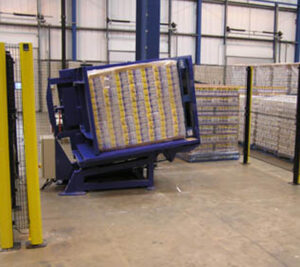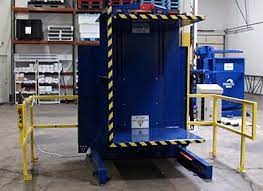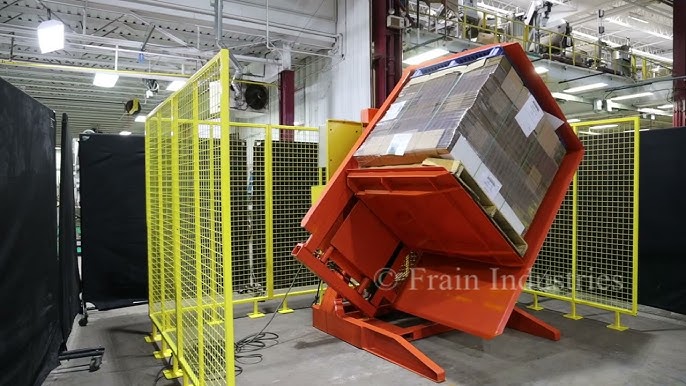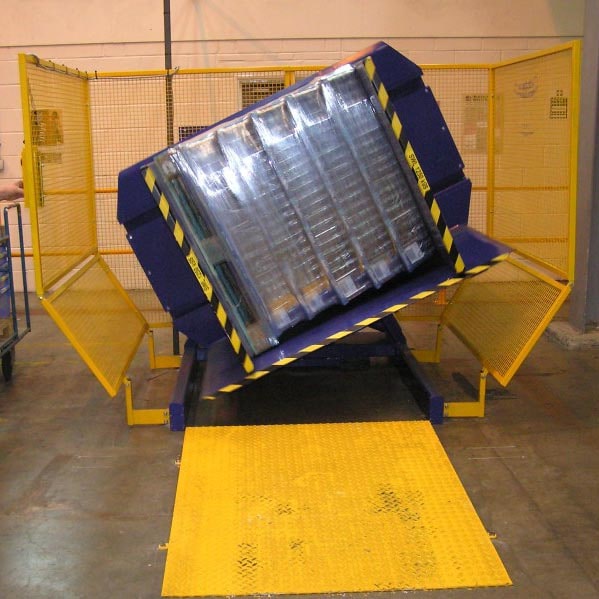Choosing the Right Pallet Inverter for Colombia's Demands in Reducing Manual Strain in Coffee and Fruit Logistics
Handling heavy pallets day in and day out is tough work. In Colombia's thriving coffee and fruit industries, this manual labor is a constant source of strain on workers. It leads to injuries, fatigue, and a high rate of employee turnover. This physical toll isn't just a human cost. It creates bottlenecks in your logistics chain, slows down processing, and can even lead to damaged goods. When your business depends on moving high volumes of coffee sacks or delicate fruits quickly and safely, this manual strain becomes a major obstacle to growth and profitability. But what if you could remove that strain entirely, protecting your people and your product at the same time?
The right pallet inverter for Colombia's coffee and fruit logistics is a machine that prioritizes gentle handling, robust construction, and operational simplicity. It must offer adjustable clamping pressure for delicate fruits, have the strength to handle heavy coffee loads, and feature user-friendly controls. This combination directly reduces manual strain, prevents product damage, and streamlines the entire pallet-handling process from the warehouse to the shipping container.

I've spent my entire career in the packing machine industry, first as an engineer and later as a factory owner. I’ve seen firsthand how a single piece of equipment can transform an entire operation. A pallet inverter is more than just a machine. It's a solution to some of the most persistent challenges in logistics. It's about creating a safer workplace and a more efficient business. Let’s explore how to choose the perfect one for your specific needs in Colombia.
How do pallet inverters specifically address manual handling challenges in the Colombian coffee supply chain?
Imagine the daily routine at a coffee processing facility. Workers have to move heavy pallets of green coffee beans, often weighing over a ton. The biggest challenge comes when you need to switch from a standard in-house wooden pallet to a plastic or heat-treated one for export. This process usually involves manually unstacking and restacking dozens of heavy sacks. This is slow, exhausting, and a primary cause of back injuries and strains. The constant lifting and moving creates a significant bottleneck, especially during peak harvest season when speed is critical. A single mistake can lead to a torn sack, spilling valuable beans and wasting both product and time.
A pallet inverter solves this problem directly and efficiently. It addresses the core manual handling challenges by completely automating the pallet exchange process. The machine securely clamps the entire loaded pallet, lifts it, and rotates it 180 degrees. The old pallet can then be easily removed from the top, and the new one placed on. The machine rotates back, gently setting the load down on the new pallet. This entire cycle takes only a minute or two and requires a single operator, with no manual lifting of sacks involved.

From Plantation Pallet to Export-Ready
The journey of Colombian coffee involves multiple pallet transfers. It arrives at the processing plant on one type of pallet and must be moved to another for international shipping to meet ISPM 15 standards. A pallet inverter becomes the central point for this transition. Instead of a team of workers spending hours on this task, a single operator can manage the entire workflow. This not only speeds up the process but also frees up your workforce for more value-added tasks, like quality control or inventory management. I remember visiting a coffee cooperative near Medellín a few years ago. Their manager told me that their biggest bottleneck was pallet switching for export containers. The manual process was so slow it limited how many containers they could ship per day. After we installed a simple 180-degree inverter, he called me a month later. He was so happy. He said they had cut their container loading time in half and completely eliminated back-injury complaints from his team.
The Importance of Clamping Pressure and Stability
Coffee sacks are heavy and can shift during handling. A key function of a pallet inverter designed for coffee is its robust clamping system. The machine must apply enough pressure to hold the entire stack of sacks securely during the 180-degree rotation, without crushing the beans. This requires a well-engineered hydraulic system that provides consistent and reliable force. The base of the machine must also be solid and stable to handle the dynamic load of a full pallet being inverted. Look for machines built with heavy-gauge steel and quality components. In my experience building these machines, the difference between a good and a great inverter often lies in the quality of the hydraulic power pack and the precision of the clamping mechanism. A cheap machine might save you money upfront, but a failure under a full load could be catastrophic.
Reducing Product Loss
Every bean counts. Manual handling inevitably leads to some product loss from torn bags or accidental spills. While a single spill might seem small, these losses add up over thousands of pallets. A pallet inverter minimizes this risk to almost zero. Because the load is clamped as a single, stable block, the sacks are not subjected to the individual pulling and dropping of manual restacking. This protects the integrity of the bags and ensures that the coffee you paid to process is the coffee you ship.
| Metric | Manual Pallet Exchange | Pallet Inverter Exchange |
|---|---|---|
| Time per Pallet | 20-30 minutes | 1-2 minutes |
| Labor Required | 2-4 workers | 1 operator |
| Risk of Injury | High (back strain, repetitive motion) | Very Low |
| Risk of Product Damage | Moderate (torn sacks, spills) | Near Zero |
| Process Consistency | Low (depends on workers) | High (machine-controlled) |
What key features should you look for in a pallet inverter for handling delicate fruits from Colombia?
Handling Colombian export fruits like physalis, passion fruit, or delicate avocados presents a completely different challenge. These products are extremely sensitive to pressure and impact. A single bruised piece of fruit can release ethylene gas, causing the rest of the box to ripen and spoil prematurely. When you are shipping high-value produce, manual handling is a huge risk. Workers might accidentally drop a box or stack them with too much force, causing damage that isn't visible until the shipment reaches its destination. This can lead to rejected shipments, financial losses, and a damaged reputation with your international customers. The goal is to transfer a full pallet of fruit without a single bruise.
For delicate fruits, the most critical feature in a pallet inverter is adjustable clamping pressure. You need a machine that can be finely tuned to "kiss" the load with just enough force to hold it securely, but not enough to cause any damage. The best machines use pressure sensors and advanced hydraulic or electric controls to allow the operator to set the exact pressure needed for different types of fruit. This is not a "one-size-fits-all" situation. The pressure for a pallet of avocados will be different from that for a pallet of berries.

The Science of Gentle Handling
Beyond just adjustable pressure, the surface that touches your product matters. Look for pallet inverters that offer soft-touch clamping pads. These are typically made of high-density rubber or a specialized polymer that cushions the load and distributes the clamping force evenly across the surface of the boxes. This prevents sharp edges or pressure points from denting the cartons and bruising the fruit inside. Another key feature is smooth, controlled rotation. A jerky or sudden start or stop during the inversion cycle can cause the contents of the boxes to shift and bruise. A quality inverter will have a variable speed control for its rotation, ensuring a gentle and smooth motion from start to finish. I once worked with a fruit exporter who was very skeptical. He believed any machine would crush his fragile berries. We brought a unit to his facility for a demonstration. We used a model with highly precise pressure controls and soft padding. We took a pallet of his most sensitive fruit and inverted it ten times in a row. Afterward, we inspected the boxes. Not a single berry was bruised. He ordered two machines on the spot.
Pallet Changer vs. Pallet Inverter
For very delicate or unstable loads, you might also consider a "pallet changer" or "pallet exchanger" instead of a traditional 180-degree inverter. These machines push the load from one pallet to another on a level plane, without tipping or inverting it. This is the gentlest method available. However, these machines are often more complex and may take up more floor space. For most boxed fruits, a well-designed 180-degree inverter with the right features is perfectly suitable and more cost-effective. The choice depends on just how fragile your product is.
Essential Features for a Fruit Pallet Inverter
| Feature | Benefit for Fruit Handling | Potential Risk if Absent |
|---|---|---|
| Adjustable Clamping Pressure | Prevents crushing and bruising of delicate fruit. | Damaged product, rejected shipments. |
| Soft-Touch Clamping Pads | Distributes pressure evenly, cushions the load. | Dented boxes, pressure point bruising. |
| Variable Speed Rotation | Ensures a smooth, gentle motion to prevent shifting. | Internal bruising from sudden movements. |
| User-Friendly Controls | Allows operators to easily set correct parameters. | Operator error leading to product damage. |
| Solid Steel Construction | Provides stability during the inversion cycle. | Unstable operation, potential safety risk. |
How does integrating a pallet inverter impact overall logistics efficiency and cost in Colombia?
In any logistics operation, you are constantly fighting against time and cost. Labor is expensive. Warehouse space is at a premium. Every minute a truck waits to be loaded or unloaded is money lost. You might find that your biggest slowdowns happen at the points of transition, like receiving or shipping, where pallets need to be handled, checked, or changed. These bottlenecks don't just slow things down; they have a ripple effect across your entire supply chain, driving up operational costs and eating into your profit margins. A manual pallet-switching process is often one of the biggest hidden costs in a warehouse.
Integrating a pallet inverter attacks these inefficiencies at their source. It transforms a slow, labor-intensive process into a fast, automated one. The most immediate impact is on labor costs. A task that required two to four workers for 20-30 minutes can now be done by one operator in under two minutes. This allows you to reassign those workers to more productive roles. But the savings go far beyond just wages. By minimizing manual handling, you drastically reduce the cost of product damage, whether it's torn coffee sacks or bruised fruit. You also reduce the risk of workplace injuries, which leads to lower insurance premiums and fewer costs associated with worker compensation claims.

Calculating Your Return on Investment (ROI)
When I started my own factory, every dollar counted. Investing in a new piece of automation felt like a huge risk. But I learned to look at it not as a cost, but as an investment. The key is to calculate the ROI. Let's take a simple example. Say you switch 50 pallets per day. Manually, this might take two workers four hours each (8 total labor hours). With an inverter, one operator might spend two hours total. You've saved 6 hours of labor every single day. Multiply that by your hourly labor rate, and you quickly see the direct savings. Now add the savings from eliminating, say, 1% product damage. Over a year, these numbers become very significant. Most of our clients find that a pallet inverter pays for itself in 12 to 24 months, and after that, it's pure profit for the business.
Speeding Up the Supply Chain
Efficiency is not just about saving money; it's about increasing throughput. A pallet inverter dramatically speeds up truck turnaround times. A driver can back into the loading dock, have pallets of goods quickly transferred to the required shipping pallets, and be on their way much faster. This means you can handle more shipments per day with the same number of loading docks. It also improves relationships with your transport partners, as no one likes to wait. Furthermore, it allows for better space optimization in your warehouse. A dedicated, fast pallet-switching station streamlines the flow of goods, preventing congestion in your receiving and shipping areas.
Cost-Benefit Analysis: A Simplified View
| Cost/Benefit Item | Manual Method (Annual Estimate) | With Pallet Inverter (Annual Estimate) | Annual Savings |
|---|---|---|---|
| Labor Cost (1 Operator) | $40,000 (2 workers) | $20,000 (1 operator, half-time) | $20,000 |
| Product Damage Cost | $15,000 (1% of value) | $1,500 (0.1% of value) | $13,500 |
| Worker Injury Claims | $5,000 | $500 | $4,500 |
| Total Annual Operational Cost | $60,000 | $22,000 | $38,000 |
| Initial Machine Investment | $0 | -$35,000 (example) | - |
| Year 1 Net Result | - | - | +$3,000 |
This simple table shows how quickly an investment in automation can turn into a net positive for your bottom line.
What are the crucial safety and maintenance considerations for pallet inverters in a high-volume environment?
You've decided to invest in a pallet inverter to boost efficiency. That's great. But now a new concern arises: safety. This is a powerful machine that lifts and rotates heavy loads. You need to be sure it can operate safely day in and day out, especially in a high-volume environment where it might be running continuously. An accident can be devastating for your workers and your business. At the same time, you worry about downtime. If this machine becomes a central part of your workflow, a breakdown during your busiest season could halt your entire operation, costing you thousands in lost revenue and delayed shipments.
The solution is twofold: choose a machine with built-in safety features and commit to a simple, regular maintenance plan. Modern pallet inverters should come standard with safety measures like light curtains or safety scanners. These create an invisible barrier around the machine. If a person or forklift crosses that barrier while the machine is in motion, it stops immediately. Physical guarding or safety fencing is also essential to prevent anyone from accidentally entering the operational area. All machines must have clearly marked emergency stop buttons that are easily accessible. These are not optional extras; they are fundamental requirements for a safe workplace.

Proactive Safety, Not Reactive Measures
Safety is also about how the machine is used. Proper operator training is crucial. Your team must understand how the machine works, its capacity limits, and all of its safety features. They need to know how to load a pallet correctly to ensure it is balanced, and how to operate the controls safely. A simple but effective feature on many modern machines is two-hand controls, which require the operator to have both hands on the control panel to start the cycle. This ensures they are standing in a safe position, away from any moving parts. As someone who has designed and built these machines, I believe safety must be engineered into the core of the machine, not just added on as an afterthought. This includes things like pressure relief valves in the hydraulic system to prevent over-pressurization and robust construction that can handle the stress of continuous use.
A Simple Maintenance Checklist for Maximum Uptime
Maintenance doesn't have to be complicated. A proactive approach is the best way to prevent unexpected downtime. In my early days as an engineer, I visited a factory that was shut down for two full days because a simple hydraulic hose on a key machine had failed. They had no preventive maintenance plan. That experience taught me a valuable lesson: maintenance isn't an expense, it's insurance against downtime. A simple checklist is all you need.
| Frequency | Task | Purpose |
|---|---|---|
| Daily | Visual Inspection | Check for any obvious damage, leaks, or loose parts. |
| Clean the Area | Keep the floor around the machine free of debris. | |
| Weekly | Check Hydraulic Fluid Level | Ensure the system has enough fluid to operate correctly. |
| Test Safety Features | Verify that light curtains and E-stops are working. | |
| Monthly | Lubricate Moving Parts | Grease bearings and chains as per the manufacturer's guide. |
| Inspect Hoses & Fittings | Look for signs of wear, cracking, or leaks in hydraulic lines. | |
| Annually | Professional Service | Have a qualified technician perform a thorough inspection. |
Following a simple plan like this will dramatically increase the reliability and lifespan of your equipment, ensuring it's always ready when you need it most.
Conclusion
Choosing the right pallet inverter transforms your Colombian logistics. It protects workers, preserves product quality, and boosts your overall efficiency and profitability. It is a strategic investment in your future.




